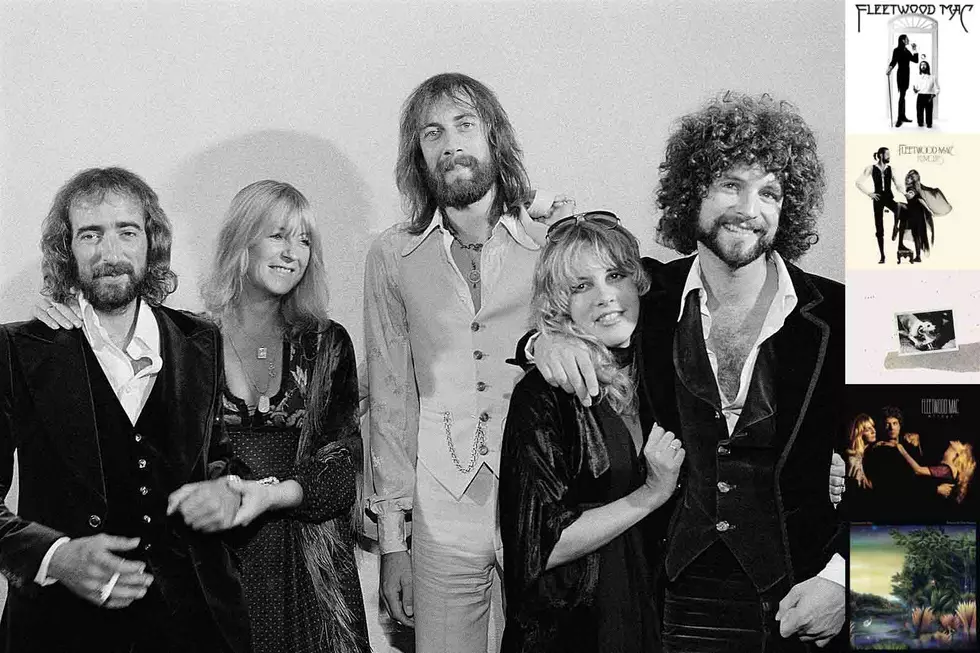
How Fleetwood Mac Made a Masterpiece That Flopped
How do you release a double album that goes multi-platinum, breaks the Top 5, spawns multiple hit singles and spends months in the Top 40 while still being widely regarded as an artistic folly and a flop? Ask Fleetwood Mac. After all, that's exactly what they did with 1979's Tusk.
Released Oct. 12, 1979 – just a few months shy of three years after their previous effort, 1977's Rumours, began its march toward record-breaking success – Tusk made up for the long wait between LPs by packing 20 tracks into its expanded length.
But as the Mac giveth, the Mac taketh away: for fans expecting a set of songs that picked up where Rumours left off, Tusk proved a confounding listen, full of artistic left turns and sonic experimentation. Some found it daring and others accused the band of self-indulgence, but no matter how you felt about the album, it was obvious that Fleetwood Mac was refusing to rest on its laurels.
This is not to say that Tusk is without its radio-friendly moments. Six singles were released in all, starting with the Top 10 title track – one of the more willfully experimental cuts on the album – and including "Sara" (No. 7) and "Think About Me" (No. 20). But it was obvious that rather than trying to recapture or outdo Rumours, the band members were willing to expend the huge amount of commercial capital they'd built up by putting together a sprawling, ambitious work that reflected many, if not all, of their wildest artistic whims.
Leading the charge was guitarist and singer Lindsey Buckingham, whose grip on the Tusk reins would later lead to some derisively referring to the record as "Lindsey's Folly." As he later took pains to explain, however, it wasn't about satisfying his ego.
"I was losing a great deal of myself," Buckingham later recalled of trying to create new music in the wake of Rumours. His solution was to cover as much musical ground as possible – to consciously avoid a Rumours II. "My thought was, let's subvert the norm. Let's slow the tape machine down, or speed it up, or put the mike on the bathroom floor and sing and beat on, uh, a Kleenex box! My mind was racing."
The end result was a set of songs that replaced the burnished AM glow of its predecessor with a sonic landscape that was broader and more colorful – yet also more arid, and studded with sharper angles.
Critics were quick to point to New Wave as an overriding influence, but Tusk wasn't an attempt to latch onto trendy sounds. As evidenced by the stomping, marching band-backed title track, or the spiky "The Ledge," or the fuzz-laced "Not That Funny," or the reverb-soaked "That's All for Everyone," it found Buckingham on nothing more than a dizzying quest to capture the sounds in his own mind.
Although Buckingham described the positive aspects of upending expectations, engineer Ken Caillat recalled a fairly turbulent working environment, with Buckingham's eccentric behavior setting the tone.
"He was a maniac," Caillat countered. "The first day, I set the studio up as usual. Then he said, 'Turn every knob 180 degrees from where it is now and see what happens.' He'd tape microphones to the studio floor and get into a sort of push-up position to sing. Early on, he came in and he'd freaked out in the shower and cut off all his hair with nail scissors. He was stressed."
He wasn't the only one. Drummer Mick Fleetwood later laughed about Warner Bros. chief Mo Ostin's apoplectic response to the finished product, paraphrasing his remarks by saying, "You're insane doing a double album at this time. The business is fucked, we're dying the death, we can't sell records, and this will have to retail at twice the normal price. It's suicide."
But in 1979, not even the head of Fleetwood Mac's record company could stop them from doing whatever they wanted. Neither could they stop a troubled narrative from being woven around the album's eventual success.
Given its length, its ambition, and its much clucked-over million-dollar cost – not to mention the mountains of rock-star excess that sprung up around Fleetwood Mac during an epic Tusk tour that included specially painted hotel rooms for singer Stevie Nicks and no shortage of on-stage tension – the record came to be regarded as a weird, costly tumble from the dizzying heights of Rumours.
Unsurprisingly, the band members took issue with this point of view. "In the context of the whole, Rumours took longer to make than Tusk. One of the reasons why Tusk cost so much is that we happened to be at a studio that was charging a fuck of a lot of money," Buckingham pointed out. "During the making of Tusk, we were in the studio for about 10 months and we got 20 songs out of it. Rumours took the same amount of time. It didn't cost so much because we were in a cheaper studio. There's no denying what it cost, but I think it's been taken out of context."
Fleetwood also insisted in a Trouser Press interview that change was part of the band's legacy. "We've never stayed one way for very long, and I don't think we ever will. We've always changed a lot whether or not players have changed," he said. "Doing a double album didn't make any business sense at all. But it meant a lot to us, artistically – whether we could still feel challenged. We really, really are pleased with it. We've also, I think, got enough discretion to know if the songs aren't up to standard, in which case we'd have just put out a single album."
Christine McVie bristled during a 1982 interview with Sounds, pointing out that "Tusk sold 9 million copies – so it can't be too shabby, can it? But a lot of people gave us flak about that album. It's very different, very different, very Lindsey Buckingham. I'll have to say that. He was going through some musical experiments at the time."
Still, the backlash took its toll, and when the sales came in considerably softer than those for Rumours – which was, it's worth noting, one of the biggest-selling records of all time – Buckingham felt that the other members of the group turned on him, jaundicing his perception of his place in the band as well as its artistic limits.
"I got a lot of support from the band during the making of Tusk; everyone was really excited about it. Then, when it became apparent that it wasn't going to sell 15 million albums, the attitude started to change – which was sad for me in a way, because it makes me wonder where everyone's priorities are," Buckingham later admitted to Record. "They changed their attitude about the music, after they realized it wasn't going to sell as many copies. That's not really the point of doing it. The point is to shake people's preconceptions about pop."
None of that helped curb Buckingham's restless artistic appetites, and before the end of the '80s, he was out of the band, temporarily off to pursue wilder (and less commercially friendly) solo vistas. But like a lot of works of art once deemed too outre, Tusk earned a deeper measure of appreciation over time. Today, it's widely regarded as one of the more interesting and artistically sounding albums in Fleetwood Mac's catalog, and all those out-there moments that perplexed Rumours fans have been hailed as influential by a widening circle of younger bands.In time, Buckingham would return to Fleetwood Mac, but the way it was perceived – and the lasting demand for Rumours-style Mac product – left a lasting impression on his career.
"For me, the Tusk album was the most important album we made, but only because it drew a line in the sand that, for me, defined the way I still think today," Buckingham mused in a 2011 interview. "I was trying to pave some new territory for us, but another way of looking at it is that I was causing trouble. Had we all wanted the same thing for the same reason, I probably never would have made solo albums."
Top 10 Double Albums
Stevie Nicks Talks About Life After Music
More From Ultimate Classic Rock









